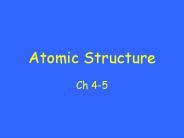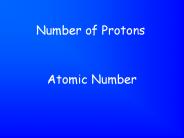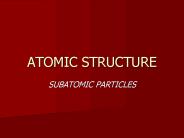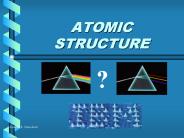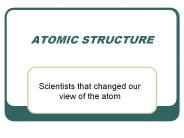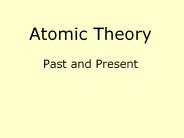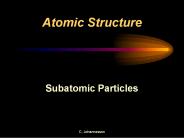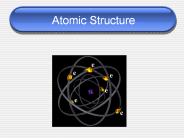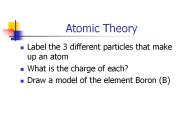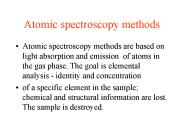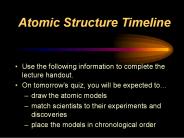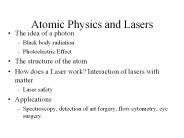Atomic PowerPoint PPT Presentations
All Time
Recommended
A History of Atomic Theory Atomic Models * * Thomson s Plum ... of matter we move from Dalton s Billard Ball Model to Thomson s Plum pudding model ...
| PowerPoint PPT presentation | free to download
Sample atomization techniques Atomic absorption instrumentation Interferences in atomic absorption spectroscopy Atomic absorption analytical techniques Atomic ...
| PowerPoint PPT presentation | free to view
Presentation for middle school to high school advanced as introduction to atomic structure. Ability to add personal text in allocated text boxes or personalization. Great for beginning teachers. Copyright Disclaimer Under Section 107 of the Copyright Act 1976, allowance is made for -fair use- for purposes such as criticism, comment, news reporting, teaching, scholarship, and research. Fair use is a use permitted by copyright statute that might otherwise be infringing. Non-profit, educational or personal use tips the balance in favor of fair use.
| PowerPoint PPT presentation | free to download
Title: Atomic Physics II Author: ML Last modified by: Created Date: 11/30/2005 2:19:20 PM Document presentation format: Company
| PowerPoint PPT presentation | free to view
Number of Protons Atomic Number Orbital Modern Model Region of space that holds 2 electrons. Has a specific energy. Shapes vary. E1 E2 Represents an electron dropping ...
| PowerPoint PPT presentation | free to download
Number of Protons Atomic Number Mass Number Number of Protons + Neutrons 12C Left Superscript = mass number 12C Left Subscript = atomic number 80Br 35 20Ne 20 27Al 27 ...
| PowerPoint PPT presentation | free to download
Atomic Structure & Periodic Table Atomic Particles Atoms Smallest piece of matter that retains the property of the element Composed of 3 particles Protons Neutrons ...
| PowerPoint PPT presentation | free to view
atomic structure subatomic particles whats in an atom? three main particles protons neutrons electrons where are they? in center: - protons - neutrons energy levels ...
| PowerPoint PPT presentation | free to download
John Dalton. Ernest Rutherford. Atomic Theory. 400 BC 1803 1904 1910 1913 1926 Title: Atomic Theories Timeline Author: Ron Last modified by: Pampa Created Date:
| PowerPoint PPT presentation | free to view
Chapter 3 Atomic Structure DEMOCRITUS Greek philosopher 470-380 BC Deduced the atom Greek for Everything in universe is made of Lavoisier Concluded a chemical ...
| PowerPoint PPT presentation | free to download
Atomic Theory ... Atomic Theory
| PowerPoint PPT presentation | free to download
ATOMIC STRUCTURE? Kenneth E. Schnobrich
| PowerPoint PPT presentation | free to download
Atomic Structure Pre-AP 8th Grade Science Parts of an Atom Protons = positive charge 1+ Neutrons = do not have a charge (0) Electrons = negative charge 1- Atoms of ...
| PowerPoint PPT presentation | free to view
Atomic Structure The smallest part of an element is an _____ All atoms consist of subatomic particles: _____ _____ _____
| PowerPoint PPT presentation | free to view
Unit 02 Atomic Structure
| PowerPoint PPT presentation | free to download
Atomic Theory 15,000 kilotons
| PowerPoint PPT presentation | free to view
ATOMIC STRUCTURE Scientists that changed our view of the atom
| PowerPoint PPT presentation | free to download
Atomic Theory Past and Present A. Democritus (400 BCE) Matter is made up of particles called atomos or atoms http://www.timelineindex.com/content/view/1228 I.
| PowerPoint PPT presentation | free to download
ATOMIC THEORY Building blocks of matter
| PowerPoint PPT presentation | free to view
Atomic Structure C. Johannesson Structure of the Atom Protons- Positively charged particles in the nucleus Neutrons-neutrally charged particles in the nucleus ...
| PowerPoint PPT presentation | free to download
Atomic Structure Subatomic Particles C. Johannesson C. Johannesson Subatomic Particles Most of the atom s mass. NUCLEUS ELECTRONS PROTONS NEUTRONS NEGATIVE CHARGE ...
| PowerPoint PPT presentation | free to download
Atomic Structure History of Atomic Theory
| PowerPoint PPT presentation | free to view
Atomic Structure Early Theories of Matter Science as we know it did not exist several thousand years ago Democritus (460-370 BC) Democritus Theory Matter is ...
| PowerPoint PPT presentation | free to download
Atomic Structure & Scientists
| PowerPoint PPT presentation | free to download
Atomic Theory Label the 3 different particles that make up an atom What is the charge of each? Draw a model of the element Boron (B) Atomic Theory Label the 3 ...
| PowerPoint PPT presentation | free to download
Title: Atomic structure Author: S.MORRIS Last modified by: YOUSUF SNIGDHA Created Date: 7/9/2006 10:27:47 AM Document presentation format: On-screen Show (4:3)
| PowerPoint PPT presentation | free to view
Atomic Structure Timeline
| PowerPoint PPT presentation | free to download
Atoms are so small that, even today, direct visual inspection is all but impossible. Our model of the atom is based on indirect experimental data.
| PowerPoint PPT presentation | free to view
Atomic Structure www.lab-initio.com Standards Modern Atomic Theory All matter is composed of atoms Atoms cannot be subdivided, created, or destroyed in ordinary ...
| PowerPoint PPT presentation | free to view
Atomic Theories Chapter 4.1 How do we know about atoms when no one has ever seen inside an atom? Greek Philosopher - Democritus Believed it is IMPOSSIBLE to divide ...
| PowerPoint PPT presentation | free to view
CH 18 Chemistry Of Earth and The Known Universe Atomic Structure Subatomic Particles Proton- P+ positive charged - in nucleus Number of P+ distinguishes one atom from ...
| PowerPoint PPT presentation | free to view
John Dalton s Atomic Theory (1808) Compounds are composed of atoms of more than one element. In any compound, the ratio of atoms is a whole number or simple fraction.
| PowerPoint PPT presentation | free to view
Atomic spectroscopy methods Atomic spectroscopy methods are based on light absorption and emission of atoms in the gas phase. The goal is elemental analysis ...
| PowerPoint PPT presentation | free to download
The atomic spectroscopy market is expected to witness market growth at a rate of 9.17% in the forecast period of 2021 to 2028. Data Bridge Market Research report on atomic spectroscopy market provides analysis and insights regarding the various factors expected to be prevalent throughout the forecast period while providing their impacts on the market’s growth. The rise in the food safety concerns globally is escalating the growth of atomic spectroscopy market.
| PowerPoint PPT presentation | free to download
3-Atomic Structure Overview Characteristics of Atoms Interaction b/tw matter and light Photoelectric Effect Absorption and Emission Spectra Electron behavior
| PowerPoint PPT presentation | free to download
The Atomic Theory Atom The smallest particle into which an element can be divided and still be the same substance. The smallest particle of an element that retains ...
| PowerPoint PPT presentation | free to view
... 6_Concourse 7_Concourse Equation RELATIVE ATOMIC MASS In order to ... of atoms and molecules Relative isotopic mass Isotopes of Hydrogen ...
| PowerPoint PPT presentation | free to view
Relative Atomic Mass & Isotopes 5.1 Until recently it was impossible to weigh individual atoms The relative scale English chemist John Dalton (1766-1844) simply ...
| PowerPoint PPT presentation | free to view
Atomic Structure Timeline Use the following information to complete the lecture handout. On tomorrow s quiz, you will be expected to draw the atomic models
| PowerPoint PPT presentation | free to download
Atomic Theory and Structure Chapters 4-5
| PowerPoint PPT presentation | free to download
Atomic Models JOHN DALTON Early 1800 s Thought atoms were smooth, hard balls that could not be broken into smaller pieces. All elements are made of atoms.
| PowerPoint PPT presentation | free to download
Title: Atoms Author: Yvonne Pierce Last modified by: Yvonne Pierce Created Date: 9/3/2006 8:50:37 PM Document presentation format: On-screen Show Company
| PowerPoint PPT presentation | free to download
Unit 3 Atoms, Sub-Atomic Particles & Nuclear Chemistry
| PowerPoint PPT presentation | free to download
The idea of a photon Black body radiation Photoelectric Effect The structure of the atom How does a Laser work? Interaction of lasers with matter
| PowerPoint PPT presentation | free to download
Atomic Trends Notes Atomic Trends The number of protons and electrons affects the properties of an atom. The periodic table is organized according to groups (up and ...
| PowerPoint PPT presentation | free to download
Atoms are electrically neutral. This is because an atom has ... Number *Because the mass ... Neutrons 12 Copy and Complete the Table Below Isotope ...
| PowerPoint PPT presentation | free to download
Unit: Atomic Structure History of the Atom Important Experiments Leading to Atomic Theory Democritus (400 B.C.) A Greek philosopher Was the first person to think ...
| PowerPoint PPT presentation | free to download
Atomic Theory and Structure John Dalton Leading to Discovery Series of meteorological observations 1787 in Manchester area Proved the validity of concept that rain ...
| PowerPoint PPT presentation | free to view
The Atomic Theory By: Jake Meister, Charles Quirk, Matt Reisin, Ben Kessler Greek Model 300 B.C.E The Greek model had the idea that everything is made out of spheres.
| PowerPoint PPT presentation | free to view
The evolution of Atomic Theory Dalton s Atomic Theory Development of structure of the atom Nucleus Dimitri Mendeleev(Periodicity) Modern periodic table
| PowerPoint PPT presentation | free to view
This report focuses on Atomic Force Microscopy (AFM) volume and value at global level, regional level and company level. From a global perspective, this report represents overall Atomic Force Microscopy (AFM) market size by analyzing historical data and future prospect.
| PowerPoint PPT presentation | free to download
CHAPTER 4 ATOMIC STRUCTURE Aristotle (Greek) Thought all substances were built from either fire, earth, air, water Thought that atoms of a liquid are smooth and round ...
| PowerPoint PPT presentation | free to download
Chapter 4: Atomic Structure
| PowerPoint PPT presentation | free to view
Unit 2 Atomic Theory * Matter All matter is made of atoms Alone as elements Au, Na, O, He In combination of elements as compounds H2O, NaCl, LiO2 Democritus (460-370 ...
| PowerPoint PPT presentation | free to download
Global Atomic Layer Deposition (ALD) Equipment Market is estimated to reach $8,059 million by 2024; growing at a CAGR of 29.1% from 2016 to 2024. Atomic layer deposition (ALD) is a thin film deposition technique based on sequential use in gas phase process.
| PowerPoint PPT presentation | free to download
History of Atomic Theory A look at early models of the atom . Historical Timeline Scientist Theory Time Published Democritus Atoms are completely solid 400 BC ...
| PowerPoint PPT presentation | free to view



